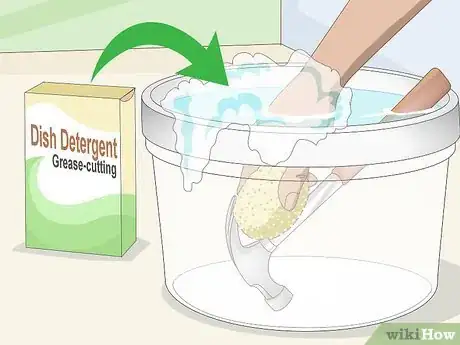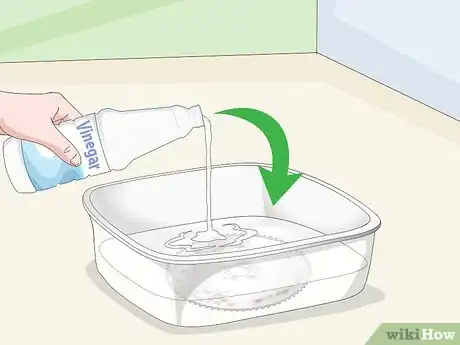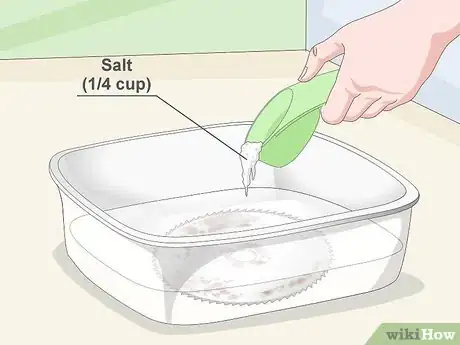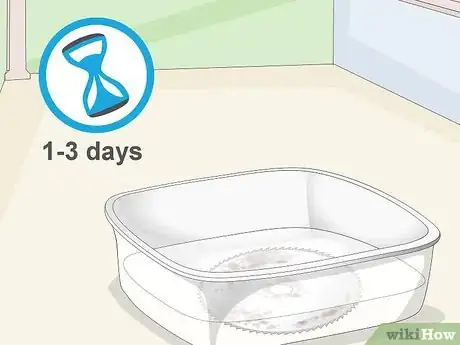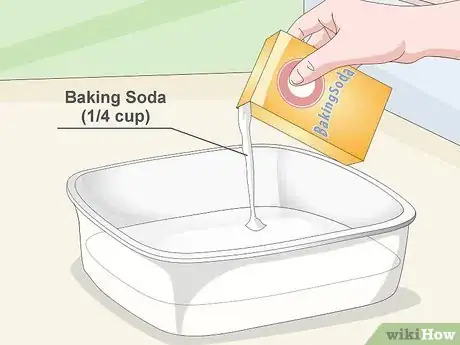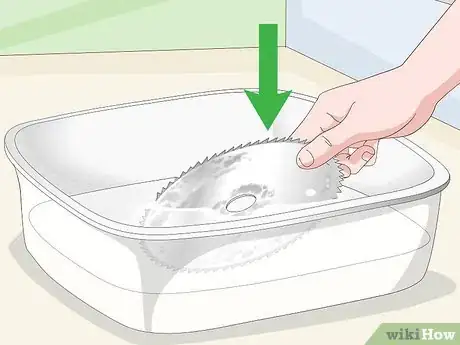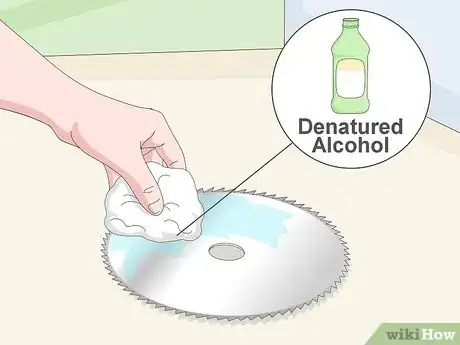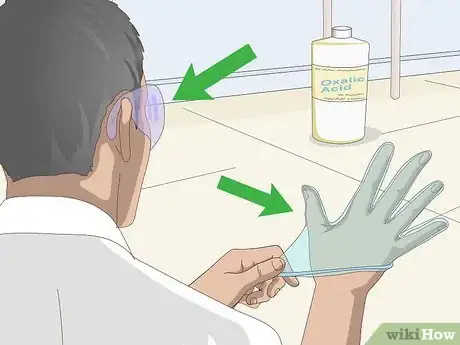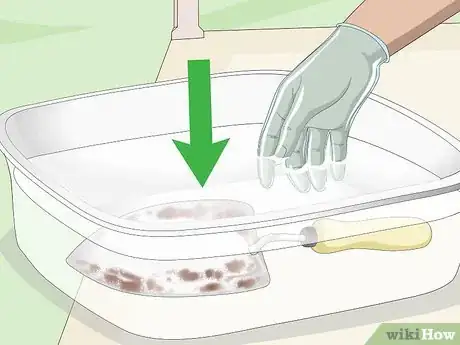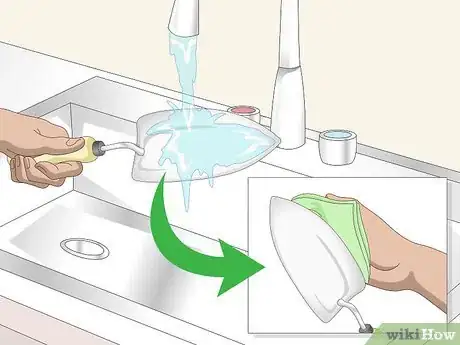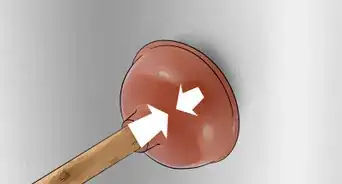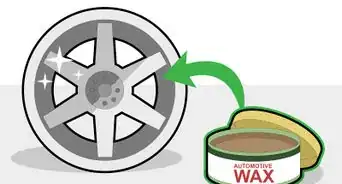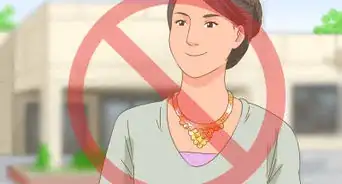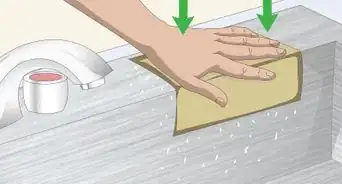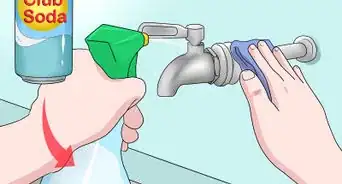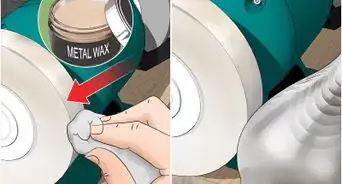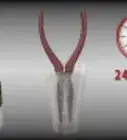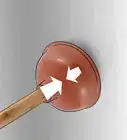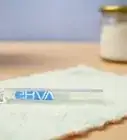This article was co-authored by Eduardo Peralta and by wikiHow staff writer, Danielle Blinka, MA, MPA. Eduardo Peralta is a House Cleaning Specialist and the Manager of Best Maid House Cleaning based in San Jose, California. With over five years of experience, Eduardo and the Best Maid House Cleaning team specialize in home deep-cleaning, post-construction cleaning, and green and eco-friendly cleaning services. Best Maid House Cleaning is fully licensed and insured.
This article has been viewed 99,853 times.
Anyone who’s worked with tools has encountered a rusty old tool that seems beyond salvage. If you have such tools in your toolbox, don’t be so quick to throw them out. It’s possible to remove rust from tools, even if the tool is covered in rust. If you have rusty tools, you can remove the rust by soaking them in dish detergent and warm water and then scrubbing the tools with steel wool or sandpaper. Additionally, you can use a vinegar and salt soak to soften the rust and then scrub it away with sandpaper. Alternatively, you can remove the rust with a commercial product like oxalic acid.
Steps
Sanding the Rust
-
1Wash away dirt and grease. Mix grease-cutting dish detergent into warm water until you get suds. Place the tools into the soapy water. While the tools are submerged, scrub them using a sponge or rag until the oil and dirt are gone, then remove the tools from the water.[1]
-
2Start with the areas most corroded by rust. Look for the thick patches of rust and start there. While you’ll clean away all of the rust, the process is easier if you work from thick rust to surface rust.
- For example, you’ll want to scrub off the flakes of rust before you attack the inset rust.[4]
Advertisement -
3Scrub the rust with coarse sandpaper or steel wool. Choose a coarse grit to begin scrubbing as it will make it easier for you to scrape off the rust. If the sandpaper gets dull, switch to a new sheet.
-
4Remove the remaining rust and unevenness with fine-grit sandpaper. Work over your piece with the fine-grit sandpaper to remove any fine speckles of rust and restore the shine to the metal. The softer quality of the paper should prevent damaging the metal of the tool.
- If your tool still has rust, then you may need to try a chemical remover.[5]
-
5Rinse and dry your tools. Once all of the rust has been sanded away, rinse your tools under clean running water to remove any debris. Dry them using a clean cloth or rag, making sure that no wetness remains.
- If you do not get your tools completely dry, more rust can develop.
- Use WD-40 on your dry tools to remove any residual moisture.
Using Vinegar and Salt
-
1Prepare your tools for treatment. If the tool is part of a larger machine, such as a table saw, disassemble your unit. Wash all of the tools or parts to be treated for rust in a mixture of grease-cutting dish detergent and warm water to remove the oils and dirt.[6]
- You can also use degreaser and scrub the item with a brush or steel wool.[7]
-
2Place your tools in a large container. You can use a plastic container, pot, or tub, as long as it’s large enough to submerge the tools. Choose a container that you can set aside for one to three days.[8]
-
3Cover the tools with white vinegar. White vinegar is acidic, so it will cut through the rust, making it easier to remove. While the amount of white vinegar will vary depending on how many tools you are cleaning and how big they are, track how much you add to the container so that you can properly measure your salt.[9]
-
4Add salt to the white vinegar. You should add roughly ¼ cup (60 milliliters) of salt for each quart (1 liter) of vinegar. The salt will increase the acidity of the vinegar so that the solution dissolves the rust quicker. Spread the salt evenly over the vinegar soak.[10]
-
5Allow your tools to soak for 1 to 3 days. The vinegar and salt need time to break down the rust so that it can be scrubbed from the tools. The longer you allow your tools to remain in the vinegar, the easier it will be to remove the rust.[11]
- At a minimum, soak the tools in vinegar overnight.[12]
- Place the container in a secure location so that children and animals won’t get into it. For example, you could lock it in your garage or shed.
- Pull out any tools with hinges or moving parts occasionally to move them around. This helps work out the rust from the crevices.
-
6Scrub the tools with a scouring pad. After you remove the tools from the vinegar solution, vigorously rub your tools to buff away the rust. Continue to scrub the tools until they are completely free of rust.
- If the rust is thick, use a metal bristle brush.[13]
- Use a small, firm toothbrush in circular motions for hard to reach areas.
-
7Rinse out the container and fill it with clean water. Pour out the vinegar solution and wash out the tub. Fill the tub with enough clean water to match the amount of vinegar solution that you’d used.[14]
-
8Add baking soda to the water. The baking soda will neutralize the acid from the vinegar so that it doesn’t remain on your tools. Use about ¼ cup (60 milliliters) of baking soda for each quart (1 liter) of water. Mix the baking soda into the water to create a solution.[15]
-
9Place the tools in the water. Make sure that your tools are submerged in the baking soda solution. Allow the tools to soak for ten minutes before removing them. Dry them well with a clean towel.[16]
-
10
-
11
Using Oxalic Acid
-
1Purchase oxalic acid. If you’d rather use a commercial rust remover, you can find oxalic acid at your local hardware or home improvement store. The acid will work more quickly than natural methods.[21]
-
2Put on your goggles and rubber gloves. Keep yourself safe while you use the oxalic acid by protecting your eyes and hands from the corrosive effects of the acid. While this step is optional, it could prevent an injury.[22]
-
3Choose a well-ventilated area. The oxalic acid will release mild fumes, so to avoid lung irritation and light-headedness you need to work in an area with good ventilation. You could open a door or window, and turn on a fan if you have one.[23]
-
4Wash the tools in soapy water. Mix grease-cutting dish detergent into warm water. Thoroughly cleanse away the dirt and oil on the tools.[24]
-
5Add one gallon (4 liters) of water to a container. Your container should be large enough to hold the water and your tools. If you need more water, then adjust the acid measurements to match the water quantity.[25]
-
6Add three tablespoons (45 milliliters) of oxalic acid to the water. Carefully mix the acid into the water. Be careful not to splash the acid onto yourself or the surrounding work area.[26]
-
7Soak your tools in the container. Add your tools to the acid solution and leave them to sit for 20 minutes. The acid needs time to break down the rust.[27]
- When you're using oxalic acid, you do not have to scrub the rust. The acid does all of the work to remove the rust.
-
8Rinse and dry the tools. Wash away the remaining acid in clean water, and then completely dry the tools with a cloth. Your tools are now ready to use or store.[28]
- If your tools still have water on them, then the rust could return.
Expert Q&A
-
QuestionDoes WD-40 clean rusty tools?
 Eduardo PeraltaEduardo Peralta is a House Cleaning Specialist and the Manager of Best Maid House Cleaning based in San Jose, California. With over five years of experience, Eduardo and the Best Maid House Cleaning team specialize in home deep-cleaning, post-construction cleaning, and green and eco-friendly cleaning services. Best Maid House Cleaning is fully licensed and insured.
Eduardo PeraltaEduardo Peralta is a House Cleaning Specialist and the Manager of Best Maid House Cleaning based in San Jose, California. With over five years of experience, Eduardo and the Best Maid House Cleaning team specialize in home deep-cleaning, post-construction cleaning, and green and eco-friendly cleaning services. Best Maid House Cleaning is fully licensed and insured.
House Cleaning Specialist Yes! Any degreaser should work for the cleaning, but you may also use a home natural product or WD-40 if you wish. Scrub the tools with a brush and a degreaser before treating the rust.
Yes! Any degreaser should work for the cleaning, but you may also use a home natural product or WD-40 if you wish. Scrub the tools with a brush and a degreaser before treating the rust. -
QuestionHow do you permanently stop rust?
 Eduardo PeraltaEduardo Peralta is a House Cleaning Specialist and the Manager of Best Maid House Cleaning based in San Jose, California. With over five years of experience, Eduardo and the Best Maid House Cleaning team specialize in home deep-cleaning, post-construction cleaning, and green and eco-friendly cleaning services. Best Maid House Cleaning is fully licensed and insured.
Eduardo PeraltaEduardo Peralta is a House Cleaning Specialist and the Manager of Best Maid House Cleaning based in San Jose, California. With over five years of experience, Eduardo and the Best Maid House Cleaning team specialize in home deep-cleaning, post-construction cleaning, and green and eco-friendly cleaning services. Best Maid House Cleaning is fully licensed and insured.
House Cleaning Specialist Do regular cleanings and always apply a rust inhibitor after each cleaning for the best conservation possible. Remember to wear gloves and eye protection when applying the inhibitor.
Do regular cleanings and always apply a rust inhibitor after each cleaning for the best conservation possible. Remember to wear gloves and eye protection when applying the inhibitor.
Warnings
- Make sure that you only use acid in a well-ventilated area.⧼thumbs_response⧽
- Be careful when handling acid. Wear protective gear like goggles and gloves.⧼thumbs_response⧽
Things You’ll Need
- Coarse sandpaper
- Fine grit sandpaper
- Steel wool
- Scouring pad
- Grease-cutting dish detergent
- Kerosene (optional)
- Electric drill with a wire wheel (optional)
- Container or tub
- White vinegar
- Salt
- Water
- Baking soda
- 0000 steel wool
- Cloth
- Denatured
- Camellia oil (optional)
- Goggles (optional)
- Rubber gloves (optional)
References
- ↑ https://www.bobvila.com/articles/how-to-remove-rust-from-tools/
- ↑ Eduardo Peralta. House Cleaning Specialist. Expert Interview. 29 October 2021.
- ↑ Eduardo Peralta. House Cleaning Specialist. Expert Interview. 29 October 2021.
- ↑ https://www.bobvila.com/articles/how-to-remove-rust-from-tools/
- ↑ https://www.bobvila.com/articles/how-to-remove-rust-from-tools/
- ↑ http://www.finewoodworking.com/2014/06/05/salt-and-vinegar-natures-rust-remover
- ↑ Eduardo Peralta. House Cleaning Specialist. Expert Interview. 29 October 2021.
- ↑ http://www.finewoodworking.com/2014/06/05/salt-and-vinegar-natures-rust-remover
- ↑ http://www.finewoodworking.com/2014/06/05/salt-and-vinegar-natures-rust-remover
- ↑ http://www.finewoodworking.com/2014/06/05/salt-and-vinegar-natures-rust-remover
- ↑ http://www.finewoodworking.com/2014/06/05/salt-and-vinegar-natures-rust-remover
- ↑ Eduardo Peralta. House Cleaning Specialist. Expert Interview. 29 October 2021.
- ↑ http://www.finewoodworking.com/2014/06/05/salt-and-vinegar-natures-rust-remover
- ↑ http://www.finewoodworking.com/2014/06/05/salt-and-vinegar-natures-rust-remover
- ↑ http://www.finewoodworking.com/2014/06/05/salt-and-vinegar-natures-rust-remover
- ↑ http://www.finewoodworking.com/2014/06/05/salt-and-vinegar-natures-rust-remover
- ↑ http://www.finewoodworking.com/2014/06/05/salt-and-vinegar-natures-rust-remover
- ↑ Eduardo Peralta. House Cleaning Specialist. Expert Interview. 29 October 2021.
- ↑ http://www.finewoodworking.com/2014/06/05/salt-and-vinegar-natures-rust-remover
- ↑ http://www.finewoodworking.com/2014/06/05/salt-and-vinegar-natures-rust-remover
- ↑ https://www.bobvila.com/articles/how-to-remove-rust-from-tools/#.WRJOtOXyuUk
- ↑ https://www.bobvila.com/articles/how-to-remove-rust-from-tools/#.WRJOtOXyuUk
- ↑ https://www.bobvila.com/articles/how-to-remove-rust-from-tools/#.WRJOtOXyuUk
- ↑ https://www.bobvila.com/articles/how-to-remove-rust-from-tools/#.WRJOtOXyuUk
- ↑ https://www.bobvila.com/articles/how-to-remove-rust-from-tools/#.WRJOtOXyuUk
- ↑ https://www.bobvila.com/articles/how-to-remove-rust-from-tools/#.WRJOtOXyuUk
- ↑ https://www.bobvila.com/articles/how-to-remove-rust-from-tools/#.WRJOtOXyuUk
- ↑ https://www.bobvila.com/articles/how-to-remove-rust-from-tools/#.WRJOtOXyuUk
- ↑ Eduardo Peralta. House Cleaning Specialist. Expert Interview. 29 October 2021.
About This Article
To clean rusty tools, start by scrubbing them in a solution of water and dish soap. Next, scrub off thick patches of rust with coarse sandpaper or steel wool. Then, use fine-grit sandpaper to remove fine specks of rust and restore the shine to the metal. Finish by rinsing the tools under clean running water, and dry thoroughly with a clean rag or towel. For more advice, including how to use commercial rust removers for faster results, keep reading.
